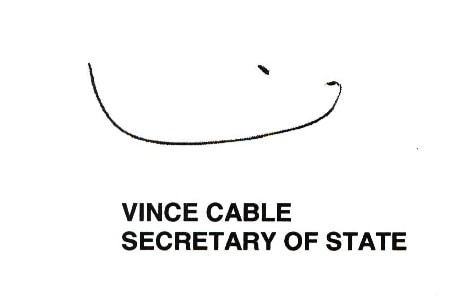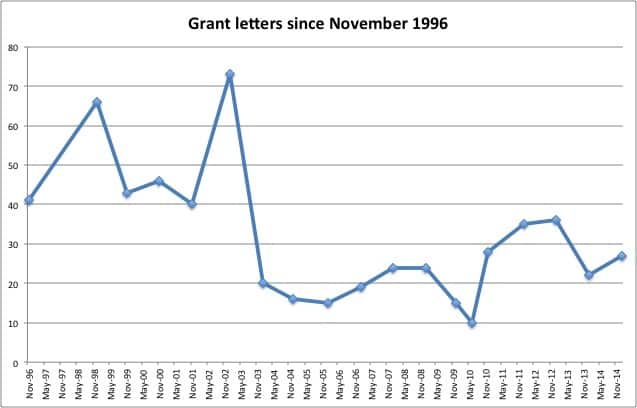Joy is unconfined as a letter is sent from a Government department
The Secretary of State for Business, Innovation and Skills has sent the annual grant letter to HEFCE. Finance directors, planners and wonks have been on the edge of their seats for days awaiting the details of what exciting spin Dr Cable would be able to put on what was essentially no news in terms of the budget for higher education.
Basically, it could be summarised as a mix of the self-referential and the self-congratulatory. It’s long on reporting all the fairly modest activities in the higher education regulatory and funding arena over the past twelve months and pretty short on anything of consequence. And there are a few exhortations to the sector to get its act together on certain (low price tag) issues, such as leadership diversity:
We have made great strides in making admission to universities open to all with the potential to succeed in higher education. We support the work you are doing on equality and diversity and welcome the report on progress and issues you sent to us in December. Equality and diversity are vital at all levels, not just admissions, but also in senior leadership. For example, currently only one Vice Chancellor in five is female and we believe the sector should go much further to seek out and harness the diverse talent available. We would like the Council to continue working with the Council of University Chairs and other sector bodies to help ensure that higher education governors and senior managers are drawn from the full range of excellent people, including who are underrepresented at the top level of higher education.
More significantly though, as has already been noted elsewhere, we have seen the most expansive signature to date from the Secretary of State (and a first outing for his sidekick):

In the good old days at the beginning of the Parliament, Dr Cable used to stick to the straightforward smiley:

Changed days indeed. But enough of that fluff you say, what about he key issues like how long was it this time?
Answer: a rather snappy 27 paragraphs spread over five pages of a 12 page package. But, as with previous years, there was quite a lot of the self-congratulation contained in a three page covering letter. Nice. And, as can be seen in the following graph, it’s pretty close to the average length for this kind of missive which is currently running at just under 32 paragraphs. It is the second shortest of the full letters of the current parliament but also the fourth longest since the beginning of 2003.

Grant letters we have known
As many will be aware, I’ve posted on this critical data set before. Rather than force everyone back to last year’s post and instead of tweaking the text to make it look original I simply reproduce here some key info about this stuff:
Of course those with longer memories will have fond recollections of the briefest of grant letters from the University Grants Committee (UGC) which simply set out the amount of money available for disbursement. Many will long for the golden age of five year funding settlements under the UGC. Whilst it could reasonably be argued that the UGC served as an effective buffer between the state and the universities, the options for the Higher Education Funding Councils, and in particular HEFCE, are much more limited as the directives from government on spending have become ever more detailed and prescriptive. Fortunately though we are able to examine all of the details of these as HEFCE has a nice collection of funding letters going back to 1996.
This decidedly dubious summary of these letters draws on this collection but refers only to English funding allocations. I’m sure the other funding councils receive similar missives from their respective governments but it is beyond my capacity to deal with them I’m afraid.
The length of funding letters has seen two peaks in the last 14 years: January 2003’s letter was 73 paragraphs long and the December 1998 note ran to 66 paragraphs. The November 1999, November 2000 and December 2001 letters ranged from 40 to 46 paragraphs but the January 2004 letter and subsequent missives tend towards the more traditional brevity of only 15-25 paragraphs of instruction to HEFCE.
Just for completeness then here are some of the details about English Higher Education’s most exciting epistles:
- The first letter in this series is the last prepared under the previous Conservative government, way back in November 1996. This 41 paragraph note (signed by a Civil Servant) covers: linking funding to assessment of teaching quality, expanding part-time provision, the importance of closer links with employers, not wanting to see longer courses, a planned reduction in student numbers by 2,000 for the following year and keeping the participation rate at around 30%. Some interesting parallels here with the most recent letter from the current government perhaps?
- The December 1998 letter is the first New Labour funding letter. At 66 paragraphs it is one of the longest in recent times and the last one to carry the name of a senior Civil Servant rather than the Secretary of State. Topics covered include sector spending, lifelong learning, increasing participation, maintaining quality and standards (a recurring theme down the years), widening access, promoting employability, research investment, capital spend, tuition fee arrangements and Year 2000 issues (we were all worried then).
- The November 1999 letter, 43 paragraphs long, provides David Blunkett with the opportunity to wax lyrical on the importance of maintaining quality and standards, increasing participation and employability, widening access, equal opportunities for HE staff, dealing with student complaints, new capital funding, pfi/ppp opportunities, research funding and HE pay.
- David Blunkett, in his November 2000 letter, which runs to a sprightly 46 paragraphs, makes some big points on widening participation as a key priority, business links and the e-university.
- In November 2001 Estelle Morris provides a neat 40 paragraph letter which gives lots of direction on widening participation, maintaining quality and standards, strengthening research, the importance of links with industry and communities, as well as something on the value of the e-Universities project (remember that?) and, last but not least, social inclusion.
- January 2003 represents the high water mark of recent funding letters: in 73 action packed paragraphs Charles Clarke, in his first outing as Secretary of State, is clearly keen to lead the way. The letter covers, among other things, improvement in research, expanded student numbers, foundation degrees, widening participation, improving teaching and learning and increased knowledge transfer. As if that were not enough we also have the establishment of the AHRC, the introduction of a new quality assurance regime but with reduced burdens for institutions (yeah, right), credit systems, FE partnerships, expanded student numbers and new investments in HE workforce development. A real blockbuster of a letter.
- The January 2004 message from Charles Clarke comes in at 20 paragraphs in just over 4 pages with reducing bureaucracy, building research and quality and standards and the establishment of Aimhigher as its central features.
- December 2004 brings a Christmas treat from everyone’s favourite Santa, Charles Clarke. With just 16 paragraphs and 4 pages of direction Clarke stresses the importance of maintaining the unit of funding for teaching, controlling student numbers and making efficiency gains.
- The January 2006 letter, a first and last offering from Ruth Kelly, comes in at a modest 15 paragraphs and 4 pages. No huge surprises in the text with employer-led provision, more widening participation, additional research and capital funding and a strong steer on reducing bureaucracy being the primary features. Additional points to note include equal opportunities for HE staff, efficiency gains, the new conditions which accompany the new tuition fees regime and reference to access agreements. What’s not to like here?
- January 2007’s is a punchy 19 paragraphs and merely five pages from Alan Johnson (his one and only letter). Despite the wordiness there isn’t a huge amount in here beyond employer engagement, growing foundation degrees and a lot on widening participation.
- January 2008: as with its successor letter this one is 24 paragraphs and 7 pages long (and note the online version on the HEFCE website is erroneously dated 18 Jan 2009). In this funding letter Denham indicates that his priorities are increasing student numbers, developing employer part-funded provision, and widening participation. The letter also refers to encouraging HE to develop stronger links with schools and colleges, greater investment in research, the importance of STEM, a green development fund, closer measuring of performance, and the establishment of the fund-raising match-funding scheme.
- January 2009’s letter is 7 pages and 24 paragraphs long and in it John Denham seeks to encourage HE to support the economy through recession, wider engagement with business, promote employer-led provision, innovative ways to support business, promotion of STEM subjects and widening participation and extending fair access. Additionally, there is the confirmation of the ‘university challenge’ with 20 new HE centres to be established, emphasis on the maintenance of quality and standards, plans for continuing to reduce regulation, commitment to dual support as well as the development of REF, steps to tackle climate change and bearing down on over-recruitment by institutions.
- The December 2009 letter from Lord Mandelson comes in at 15 paragraphs. This short note follows up on Higher Ambitions (which, in case you had forgotten, “sets out a course for how universities can remain world class, providing the nation with the high level skills needed to remain competitive, while continuing to attract the brightest students and researchers”) and also covers the Economic Challenge Investment Fund, wider and fairer access to HE, increasing the variety of undergraduate provision, new funding incentives to deliver higher level skills, developing REF, new developments in quality assurance including the publication of a standard set of information for students, engaging with communities and penalizing institutions which over-recruit students.
- June 2010 sees the first funding letter from the new coalition government: Cable and Willetts give us 10 brief paragraphs covering initial savings, efficiencies and cuts but also 10,000 extra places (but with strings).
Happy days. Bets are currently being taken on the next Secretary of State and what her or his signature will look like.













The link to HEFCE’s funding letters catalogue is dead: http://www.hefce.ac.uk/finance/grant/.
It’s now at http://www.hefce.ac.uk/whatwedo/invest/institns/annallocns/govletter/.